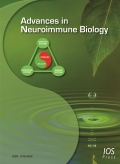Authors: Berczi, Istvan | Quintanar Stephano, Andres
Article Type:
Research Article
Abstract:
The adaptive immune system (ADIM) involves the bone marrow that produce bone marrow derived (B) lymphocytes, and also release precursor cells for thymus derived (T) lymphocytes. B cell produce antibodies and regulate antibody formation, T cells mediate cellular immunity by killer T cells, and T cells mediating delayed type hypersensitivity. During an ADIM response, T and B lymphocytes proliferate, and their receptors undergo somatic mutation and clonal selection in order to generate highly specific antigen receptors. Seven to ten days needed for an adaptive immune response to develop. Antigen presenting cells (APC) initiate the ADIM response. Innate immunity (INIM) protects
…us for life. Innate antigen receptors are germ line coded, constant and polyspecific. The bone marrow produces monocyte/macrophages which recognize antigen, CD5+ B lymphocytes producing polyreactive natural antibodies, and polymorhonuclear granulocytes which are phagocytic cells. Natural killer, NK and NKT cells, and suppressor/regulatory T (Ts/r) cells are thymus derived. Cytokines are produced by monocytee/macrophages, NK, NKT Ts/r cells. The liver produces acute phase proteins (APP). Complement, properdin, defensins, scavenger receptors, enzymes and numerous other substances function as APP. The INIM system is capable of instantaneous defense at any time even under adverse conditions it will protect the host. During homeostasis both the adaptive and innate immune systems are regulated by vasopressin (VP) and everything works in harmony. During acute illness immune derived cytokines induce the acute phase response (APR), which is an emergency defense reaction against life threatening insults. During APR the INIM system is stimulated rapidly (maximum ~1000 times, within 24–48 hours) and take over host defense as the ADIM system is not capable for a rapid response, and it is suppressed. Major endocrine, metabolic, and immune alterations take place. The HPA axis, sympathetic nervous system, glucocorticoids, catecholamines, pro-inflammatory cytokines, the brain, liver and white blood cells mediate APR. Fever and catabolism are hallmarks of APR. APR is the last effort by the organism to survive a life threatening event. In the overwhelming majority, febrile illness will be followed by recovery, which indicates the efficiency of this reaction. As a rule acute febrile illness will subside and chronic inflammatory disease will follow. During chronic inflammation VP becomes the hypothalamic regulator of immune and inflammatory process. Recovery will follow in most instances. The neuroendocrine, metabolic and immune abnormalities will be normalized and VP will serve as the hypothalamic factor regulating bodily functions during homeostasis. In cases when chronic stress does not subside, the INIM system will remain activated, and because of the excess energy requirement of this system cachexia may develop, which may be a lethal condition.
Show more
Keywords: Stress, adaptive immunity, innate immunity, acute illness, conditioned immune reactions
DOI: 10.3233/NIB-012911
Citation: Advances in Neuroimmune Biology,
vol. 3, no. 3-4, pp. 277-285, 2012
Price: EUR 27.50





